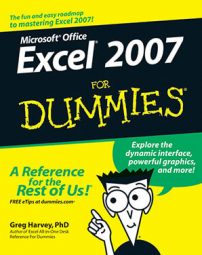A basic printing technique you may need in Excel 2007 is how to print the worksheet formulas instead of printing the calculated results of the formulas. You can check over a printout of the formulas in your worksheet to make sure that you haven’t done anything stupid (like replace a formula with a number or use the wrong cell references in a formula) before you distribute the worksheet companywide.
Follow these steps to print formulas in an Excel 2007 worksheet:
On the Formulas tab of the Ribbon, click the Show Formulas button in the Formula Auditing group.
Excel displays the contents of each cell in the worksheet as they normally appear only in the Formula bar or when you’re editing them in the cell. Notice that value entries lose their number formatting, and long text entries no longer spill over into neighboring blank cells. Excel widens the columns with best-fit so that the formulas appear in their entirety.
With the formulas displayed, print the worksheet as you normally would any other report.
Return the worksheet to normal by clicking the Show Formulas button again or by pressing Ctrl+` (the angled apostrophe next to the 1 key).
Excel allows you to toggle between the normal cell display and the formula cell display by pressing Ctrl+`. (That is, press Ctrl and the key with the tilde [~] on top.) This key — usually found in the upper-left corner of your keyboard — does double-duty as a tilde and as a weird backward accent mark: ` (Don’t confuse that backward accent mark with the apostrophe that appears on a key below the quotation mark!)
You can include the worksheet column letters and row numbers as headings in the printout so that if you do spot an error, you can pinpoint the cell reference right away. To include the row and column headings in the printout, put a check mark in the Print check box in the Headings column on the Sheet Options group of the Page Layout tab before you send the report to the printer.

